
Table of Contents
Great companies don’t hire skilled people and motivate them, they hire already motivated people and inspire them.
Simon Sinek
HR letters are an important part of the HR processes. HR letters play an important role in creating great experiences for the employees. They also help in moulding the culture of the company.
HR letters are the foundation for successful communication inside an organisation. They help in setting the right expectations for employees. Whether it’s to welcome new employees, or to inform employees of a new policy, provide feedback on performance, or extend a job offer, HR letters help to ensure a smooth and consistent process for all parties involved.
Top HR Letters for Onboarding Process
One of the core areas where HR letters are most useful is the new employee onboarding process. As new employees need to understand the company’s policies, procedures, and expectations, HR letters help in providing the much needed clarity and transparency. Letters also help to meet legal requirements, and provide a record of the onboarding process for any future reference. HR letters play a critical role in ensuring a smooth and successful onboarding experience.
While an organisation can exchange a number of letters with the new employees, here are the most important ones which cannot be missed:
- Offer letter
- Welcome letter
- Pre-onboarding email/letter
- Onboarding process explainer email/letter
- Employee onboarding requirements email
- Employee handbook acknowledgement email
- Performance review explainer email
- Safety training email
Let’s deep dive into the contents of each of these emails. We are also providing samples for each of the letters for your convenience.
1. Offer Letter
This is a formal letter that is sent to the selected candidate after they have accepted your job offer. This letter states the terms and conditions of employment. It includes details such as the job start date, salary structure, job title, and other benefits. Points to be mentioned in an Offer Letter are:
- Job title and description
- Start date and hours of work
- Salary and compensation details
- Benefits and perks offered
- Reporting structure and location
- Probationary period, if any
- Any specific terms or conditions of employment
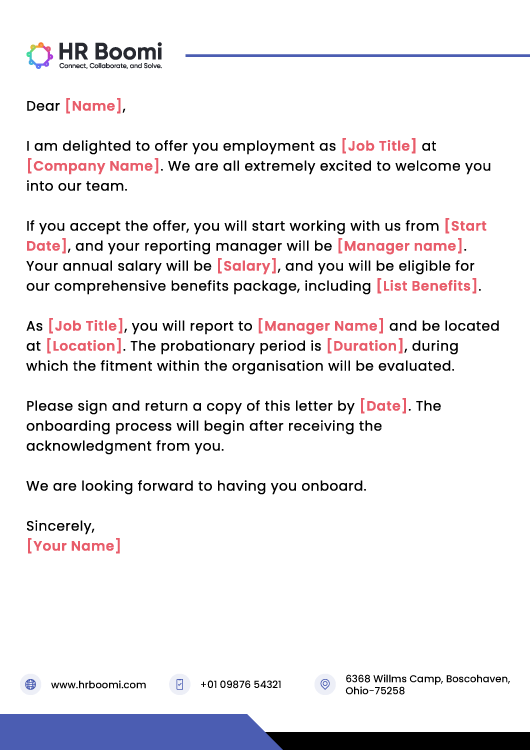
2. Welcome Letter
A welcome letter is typically sent to the new employee before their start date to welcome them to the company and outline the next steps in the onboarding process. Points to be mentioned in a Welcome Letter are:
- A warm welcome to the company
- Information about the start date, orientation, and training
- An overview of the onboarding process and next steps
- Details about the employee’s supervisor, team, and location
- An invitation to reach out with any questions
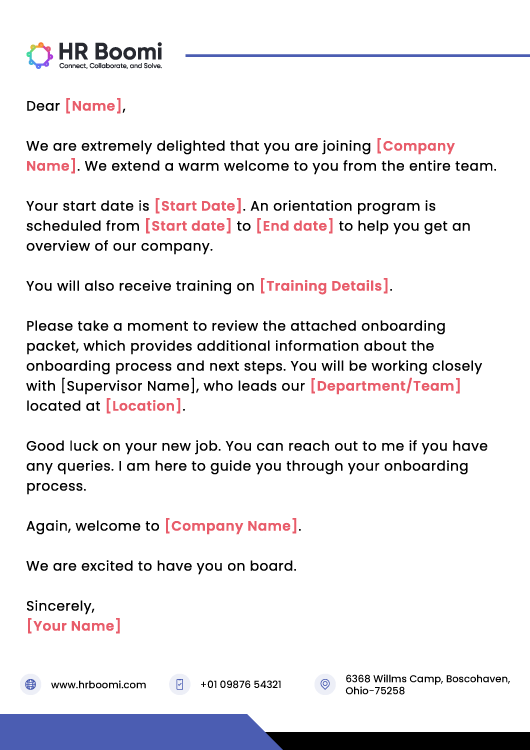
Looking for more inspiration to welcome new team members? Head over here for best welcome messages.
3. Pre-Onboarding Email
A Pre-Onboarding Email is sent before the employee’s first day of work to provide information about the onboarding process and what the employee can expect. A Pre-Onboarding Email should contain:
- A warm welcome to the company
- Details on the onboarding schedule and agenda
- Information about the company culture and values
- List of documents to be brought for verification (e.g. ID, work permits, etc.)
- Details of their first contact at the office
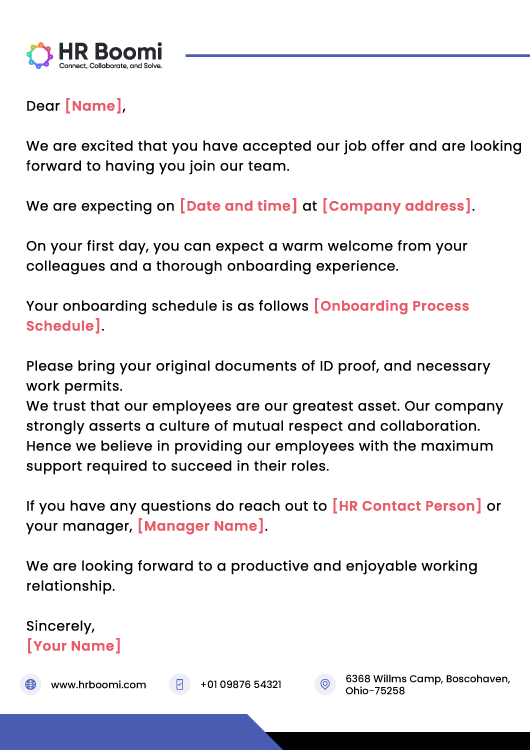
4. Onboarding Process Email
An Onboarding Process Email is sent during the employee’s first few days on the job to provide information about the onboarding process and what the employee can expect. An Onboarding Process Email can contain:
- An overview of the onboarding process and what the employee can expect
- Information about company policies and procedures
- Details on the employee’s role and responsibilities
- Details on how the employee will receive feedback and support
- Information about the company culture and values
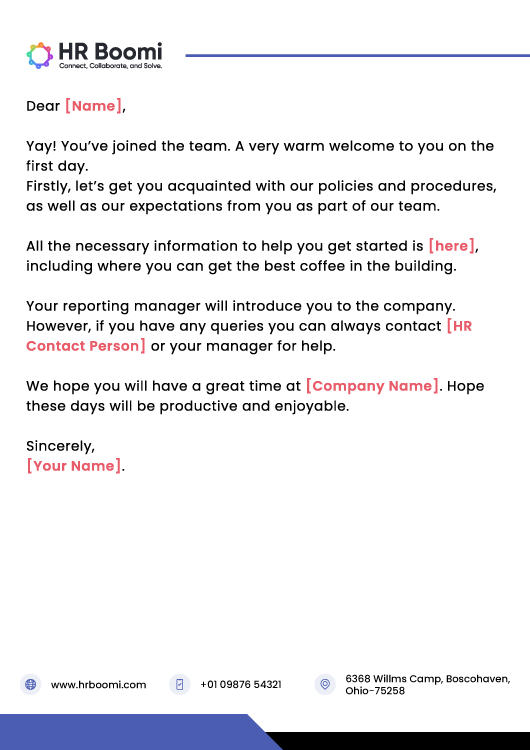
5. Employee Onboarding Requirements Email
This communication from HR to newly hired employees details all necessary steps and documents required for their onboarding process. Its aim is to give a comprehensive view of this step-by-step journey so newcomers feel supported as they navigate their way into their company.
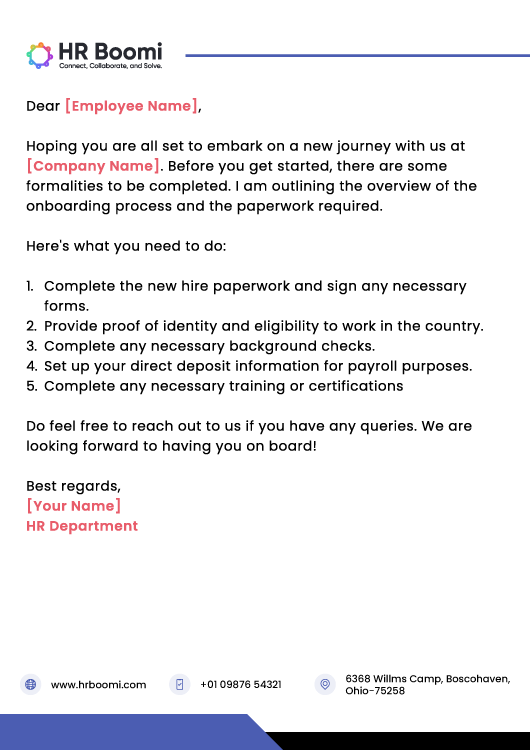
6. Employee Handbook Acknowledgment
HR teams send this email to confirm that the employee has received and read the company’s employee handbook. Points that the team can mention in an Employee Handbook Acknowledgment Letter are:
- A reference to the employee handbook
- A request for the employee to acknowledge receipt and review of the handbook
- A reminder that the handbook forms part of the employee onboarding process and needs to be understood in its entirety
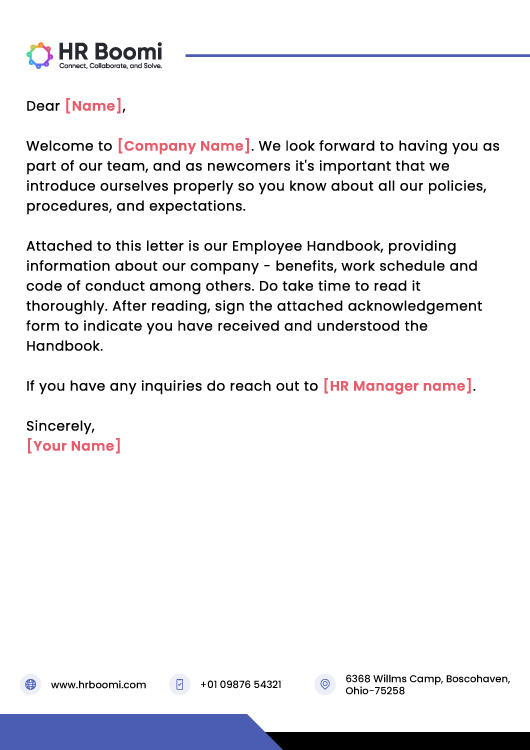
7. Performance Review Explainer Email
This letter is sent to explain the company’s performance review process and schedule the employee’s first performance review. Points to be mentioned here are:
- An overview of the performance review process
- The employee’s first performance review date and time
- Information on who will conduct the review
- Details on how the review will be conducted
- Information on how the employee can prepare for the review
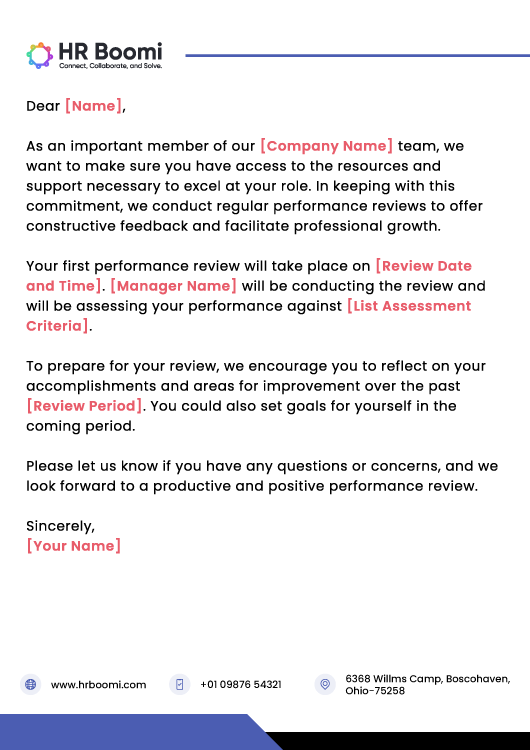
8. Safety Training
A Safety Training letter is sent to outline the safety training requirements for the employee’s job and schedule the employee for the necessary training. The contents of this letter should include:
- An overview of the company’s safety policies and procedures
- A list of required safety training sessions
- The dates and times of the scheduled training sessions
- Information on who will conduct the training
- Details on how the employee can prepare for the training

HR teams can conclude the onboarding process with a survey conducted online via emails or in offline mode. This survey should help them understand if their onboarding process was effective and complete.
Conclusion
To sum it up, the onboarding process is a critical aspect of any organization, and HR letters can play a crucial role in ensuring a smooth onboarding for new employees. From offer letters to welcome emails and performance schedules, these letters set the tone for a positive employee experience and foster a sense of belonging. By utilizing top HR letters, organizations can enhance communication, provide clarity, and create a strong foundation for successful onboarding.
Recent Posts
-

In-house vs. Outsourced Payroll: Pros and Cons
-

Mastering Talent Retention: A Corporate Challenge
-

What is employer branding and how to apply it in your company?
-

The Significance of Employee Communication Within
-

What is time management and why is it important?
-

Net salary: what is it and how is it calculated?
-

Enhancing Employee Experience: Strategies for Excellence
-

10 Best Gifts to Boost Sales Channels
